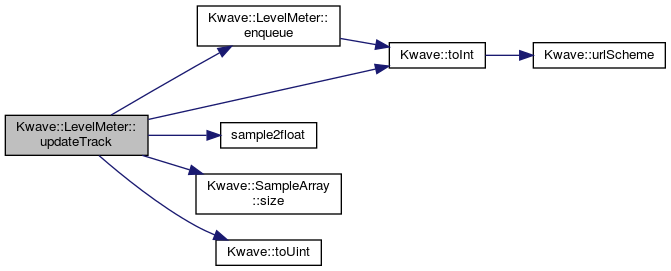#include <LevelMeter.h>


Public Slots | |
| virtual void | setTracks (unsigned int tracks) |
| virtual void | setSampleRate (double rate) |
| virtual void | updateTrack (unsigned int track, const Kwave::SampleArray &buffer) |
| virtual void | reset () |
| virtual void | drawContents () |
Public Member Functions | |
| LevelMeter (QWidget *parent) | |
| virtual | ~LevelMeter () Q_DECL_OVERRIDE |
| virtual void | paintEvent (QPaintEvent *) Q_DECL_OVERRIDE |
| virtual void | resizeEvent (QResizeEvent *) Q_DECL_OVERRIDE |
Protected Slots | |
| virtual void | timedUpdate () |
Protected Member Functions | |
| virtual void | enqueue (unsigned int track, float fast, float peak, unsigned int queue_depth) |
| virtual bool | dequeue (unsigned int track, float &fast, float &peak) |
| void | drawScale (QPainter &p) |
Private Attributes | |
| int | m_tracks |
| float | m_sample_rate |
| QVector< float > | m_yf |
| QVector< float > | m_yp |
| QVector< QQueue< float > > | m_fast_queue |
| QVector< QQueue< float > > | m_peak_queue |
| QVector< float > | m_current_fast |
| QVector< float > | m_current_peak |
| QTimer * | m_timer |
| QColor | m_color_low |
| QColor | m_color_normal |
| QColor | m_color_high |
Detailed Description
Definition at line 39 of file LevelMeter.h.
Constructor & Destructor Documentation
◆ LevelMeter()
|
explicit |
Constructor
Definition at line 54 of file LevelMeter.cpp.
References Kwave::connect(), m_timer, and timedUpdate().

◆ ~LevelMeter()
|
virtual |
Destructor
Definition at line 71 of file LevelMeter.cpp.
References setTracks().

Member Function Documentation
◆ dequeue()
|
protectedvirtual |
Dequeue a pair of fast and peek value of a track.
- Parameters
-
track index of the track [0...m_tracks-1] fast receives the value of the fast level bar [0.0 ... 1.0] peak receives value of the peak level [0.0 ... 1.0]
- Returns
- true if there was something to dequeue, false if the queue was empty.
- Note
- fast and peak will not be modified if the queue was empty
Definition at line 226 of file LevelMeter.cpp.
References m_fast_queue, m_peak_queue, m_tracks, and Kwave::toInt().
Referenced by timedUpdate().


◆ drawContents
|
virtualslot |
Redraws the whole widget
Definition at line 344 of file LevelMeter.cpp.
References background, drawScale(), m_color_high, m_color_low, m_color_normal, m_current_fast, m_current_peak, m_tracks, rect(), and Kwave::toUint().
Referenced by paintEvent().


◆ drawScale()
|
protected |
Draw some scale into the meter, using 3dB steps
- Parameters
-
p an already opened QPainter
Definition at line 272 of file LevelMeter.cpp.
References background, rect(), and Kwave::toInt().
Referenced by drawContents().


◆ enqueue()
|
protectedvirtual |
Enqueue a pair of fast and peak value of a track for later timed update. If the queue already contains the maximum number of elements, the oldest ones will be removed.
- Parameters
-
track index of the track [0...m_tracks-1] fast value of the fast level bar [0.0 ... 1.0] peak value of the peak level [0.0 ... 1.0] queue_depth maximum number of elements to queue
Definition at line 192 of file LevelMeter.cpp.
References m_fast_queue, m_peak_queue, m_timer, m_tracks, Kwave::toInt(), and UPDATES_PER_SECOND.
Referenced by updateTrack().


◆ paintEvent()
|
virtual |
- See also
- QWidget::paintEvent
Definition at line 77 of file LevelMeter.cpp.
References drawContents().

◆ reset
|
virtualslot |
Resets all meters to zero
Definition at line 174 of file LevelMeter.cpp.
References m_current_fast, m_current_peak, m_fast_queue, m_peak_queue, m_timer, m_tracks, m_yf, and m_yp.
Referenced by setTracks().

◆ resizeEvent()
|
virtual |
◆ setSampleRate
|
virtualslot |
sets the sample rate for interpreting the samples used for updating the display.
Definition at line 97 of file LevelMeter.cpp.
References m_sample_rate.
◆ setTracks
|
virtualslot |
sets the number of tracks that the display should use
Definition at line 89 of file LevelMeter.cpp.
References m_tracks, reset(), and Kwave::toInt().
Referenced by ~LevelMeter().


◆ timedUpdate
|
protectedvirtualslot |
Called via m_timer to update the bar(s)
Definition at line 250 of file LevelMeter.cpp.
References dequeue(), m_current_fast, m_current_peak, and m_tracks.
Referenced by LevelMeter().


◆ updateTrack
|
virtualslot |
Updates a apecific track
- Parameters
-
track index of the track buffer array with samples
Definition at line 104 of file LevelMeter.cpp.
References enqueue(), F_FAST_DECAY, F_FAST_RISE, F_PEAK_DECAY, F_PEAK_RISE, m_sample_rate, m_tracks, m_yf, m_yp, sample2float(), Kwave::SampleArray::size(), Kwave::toInt(), Kwave::toUint(), and UPDATES_PER_SECOND.

Member Data Documentation
◆ m_color_high
|
private |
color high levels, above -1.5dB
Definition at line 159 of file LevelMeter.h.
Referenced by drawContents().
◆ m_color_low
|
private |
color for low levels, below -3dB
Definition at line 153 of file LevelMeter.h.
Referenced by drawContents().
◆ m_color_normal
|
private |
color for normal levels, -3dB...-1.5dB
Definition at line 156 of file LevelMeter.h.
Referenced by drawContents().
◆ m_current_fast
|
private |
current fast value for each track
Definition at line 144 of file LevelMeter.h.
Referenced by drawContents(), reset(), and timedUpdate().
◆ m_current_peak
|
private |
current peak value for each track
Definition at line 147 of file LevelMeter.h.
Referenced by drawContents(), reset(), and timedUpdate().
◆ m_fast_queue
|
private |
queues with fast update values for each track
Definition at line 138 of file LevelMeter.h.
◆ m_peak_queue
|
private |
queues with peak values for each track
Definition at line 141 of file LevelMeter.h.
◆ m_sample_rate
|
private |
sample rate used for interpreting the received buffers
Definition at line 129 of file LevelMeter.h.
Referenced by setSampleRate(), and updateTrack().
◆ m_timer
|
private |
timer for display updates
Definition at line 150 of file LevelMeter.h.
Referenced by enqueue(), LevelMeter(), and reset().
◆ m_tracks
|
private |
number of tracks
Definition at line 126 of file LevelMeter.h.
Referenced by dequeue(), drawContents(), enqueue(), reset(), setTracks(), timedUpdate(), and updateTrack().
◆ m_yf
|
private |
last output value of the filter for fast updates
Definition at line 132 of file LevelMeter.h.
Referenced by reset(), and updateTrack().
◆ m_yp
|
private |
last output value of the filter for peak updates
Definition at line 135 of file LevelMeter.h.
Referenced by reset(), and updateTrack().
The documentation for this class was generated from the following files:
- plugins/record/LevelMeter.h
- plugins/record/LevelMeter.cpp
